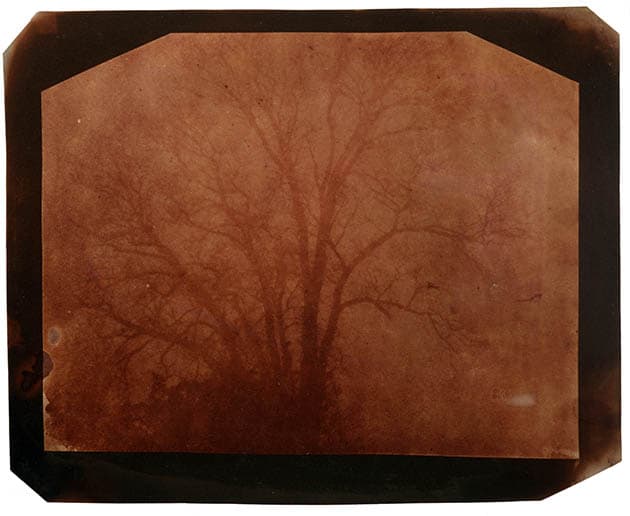Among the mystery images is this one entitled: ‘A Forbidding Stand of Winter Trees’, a salt print from a photogenic drawing negative, probably from winter 1839/1840. It is not yet known which of Talbot’s chemical experiments created this effect [Photo credit: © William Talbott Hillman Collection].
The Bodleian Libraries at the University of Oxford are putting together an online catalogue ‘raisonné’ in a bid to enable scholars and members of the public to view and search the entire photographic works of Fox Talbot.
The public will be able to play a part in photographic history by identifying people pictured in Talbot’s images or the location of featured buildings, for example.
Professor Larry J Schaaf, director of the Talbot catalogue raisonné at the Bodleian Libraries, said: ‘With a volunteer army of contributors, I hope we’ll discover new photographs and that new research questions will arise.’
The Bodleian Libraries said in a statement: ‘The website will invite members of the public and scholars from a range of fields – from architecture to botany – to add to the catalogue, for example, by helping identify unknown people or buildings in photographs or contributing research related to Talbot’s life and work.’
Around 25,000 Fox Talbot original negatives and prints are known to survive worldwide, charting the technical and aesthetic progress of the new art of photography.
The Bodleian Libraries added: ‘However, there is still more that researchers want to find out about these works and, more broadly, the invention of photography and the emergence of Talbot himself as the first photographic artist.’
Organisers say the project ‘will help unlock the enormous artistic, documentary and technical information embodied in these images’.
They add: ‘[The online catalogue] will shed new light on Talbot’s photographic discoveries and will invite academics and the public to help fill in the blanks about mystery images.’
Among the mystery photos is one entitled ‘A Forbidding Stand of Winter Trees’ (pictured above). A spokesperson explained: ‘Rising out of an unearthly and unfamiliar landscape, the skeletal form of a tree reaches through a fiery red sky.
‘Whichever of Talbot’s various chemical experiments led to this unearthly effect is at present unknown, but one of the aims of the catalogue raisonné is to encourage historians and conservators to answer this sort of question.’
Images of prints and negatives on the website will be accompanied by notes, annotations and essays with links to relevant publications and other sites.
The database will also feature the work of Talbot’s close circle of family and colleagues who collaborated in the inventor’s photographic projects.
The website is due to go live later this year.
 The Victualling Office, Plymouth, from the Battery at Mt. Edgcumbe. Salt print from a calotype negative, September 1845 [Photo credit: © Photographic History Collection, Smithsonian’s National Museum of American History, 67.172.54]
The Victualling Office, Plymouth, from the Battery at Mt. Edgcumbe. Salt print from a calotype negative, September 1845 [Photo credit: © Photographic History Collection, Smithsonian’s National Museum of American History, 67.172.54]
 Carriage in the courtyard of Lacock Abbey. Salt print from a calotype negative, April 1844 [photo credit: © William Talbott Hillman Collection]
Carriage in the courtyard of Lacock Abbey. Salt print from a calotype negative, April 1844 [photo credit: © William Talbott Hillman Collection]







